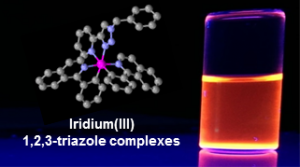Luminescent Metal Complexes for Applications in Biology and Analytical Chemistry
Luminescent transition metal and lanthanoid complexes are attractive alternatives to traditional organic fluorophores. Phosphorescent Ir(III), Re(I) and Ru(II) complexes have considerable potential as luminescent probes as strong spin–orbit coupling, induced by the heavy metal atom, promotes efficient intersystem crossing to the 3MLCT state. The subsequent emission from the 3MLCT state often results in relatively long-lived phosphorescence with large Stokes’ shifts that minimise the self-quenching and the complexes are relatively resistant to photobleaching.

In previous work we prepared 1,2,3-triazole heterocyclclic ligands using Cu(I) catalysed azide–alkyne cycloaddition “click” chemistry and the ligands were used to form phosphorescent Ir(III) and Ru(II) complexes. We can tether the luminescent complexes to proteins such as the metalloprotein transferrin. The Ir(III)/Ru(II)–protein conjugates can be visualised in cancer cells using live cell imaging for extended periods without significant photobleaching. We are aiming to use these versatile phosphorescent protein-labelling agents to label proteins that are central to neurodegenerative diseases (Amyotrophic Lateral Sclerosis, Alzheimer’s and Parkinson’s disease).

In the Figure above we have labelled the iron protein transferrin with a phosphorecent iridium(III) complex to enables visualisation of protein trafficking using live cell fluorescent imaging.